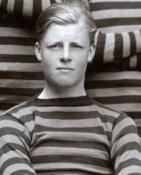
War Memorial
| Lieutenant Philip Gordon CARR | |
|
7th (Princess Royal’s) Dragoon Guards Date of birth: 9th October 1897 Date of death: 13th March 1978 Survived aged 80 Unknown |

|
| Philip Gordon Carr was born at Crockham Hill in Kent on the 9th of October 1897 the second son of Philip William Carr, a stockbroker, and Louise S. (nee Yates) Carr of Dennett Lodge, Crockham Hill. He was educated at Hazelwood School until December 1910 where he was a member the Choir, and of the Football XI in 1908, 1909 and 1910. He was a member of the Cricket XI in 1909 and 1910. The school magazine wrote the following on his 1909 cricket season: - "At present is a very rough bat and does not listen to what he is told. Has the makings of a good bowler and is a brilliant but not safe field." Of his 1910 cricket season they wrote: - "A fine cover point, and on a fast wicket, a really first rate bowler, varying pitch, pace, and break in disconcerting fashion; is a slashing and determined hitter, who can also "sit on the splice" but his objection to coaching has retarded his advance as a batsman." The magazine wrote the following on his 1908 football season: - "(Inside right) - A very promising forward, with plenty of dash, and much cleverness in out witting the defence; has learnt how to make proper use of his partner on the wing; at present his fault is a tendency to lose his head in front of goal." Of his 1909 football season they wrote: - "(Centre forward) - Undoubtedly clever, passing deftly and initiating many subtle movements, and when in proper vein is a really fine shot. His play has certainly suffered from inadequate support, but he is somewhat lacking in perseverance and "grit". Must also correct an aptitude to assume the post of mentor of the team." They wrote of his 1910 football season: - "(Centre forward) - A very clever dribbler with a good knowledge of the game. Shooting well with either foot, he is always dangerous in the proximity of the goal, and claims a large percentage of the points to our credit. Must remember that it is part of his duty to frustrate the movements of the opposing half, when our own citadel is besieged." On leaving the school the magazine wrote of him: - "One of the finest all round sportsmen Hazelwood has produced. Has only one superior upon the football field, and was a prominent member of the Cricket XI. Sang in the choir, and is to be congratulated on the good use he has made of his brains as well as of his physical powers." He went on to Sherborne School where he was in School House from January 1911 to July 1914 and was a member of the Cricket XI in 1914. The Sherbourne School magazine wrote of his cricket season that year: - "A great disappointment. Will never get runs until he learns to stand still. Might make a useful bowler if he fixes his attention on his length and could shorten his run. A good extra cover.". He went on the Royal Military Sandhurst from where he was commissioned as a 2nd Lieutenant in the 7th (Princess Royal's) Dragoon Guards on the 16th of December 1914. He underwent further training at Camberly and was later stationed at Tidworth with the 4th Reserve Regiment of Cavalry. He went to France in 1916 aged just 18. He was promoted to Captain on the 25th of April 1917. In 1918 he spent 9 months in hospital following an operation and was ordered an open air cure for six months before joining the Regimental Depot at Dunbar and being invalided out of the army in December 1918. After the war he was admitted as a member of the Stock Exchange from the 25th of March 1919 and he lived at 24 Vicarage Close, Marlborough in Wiltshire. He was recalled to the army on the outbreak of the Second World War and served as a Captain with the 4/7th Royal Dragoon Guards. |
|
| Went on to Sherbourne School |
Back